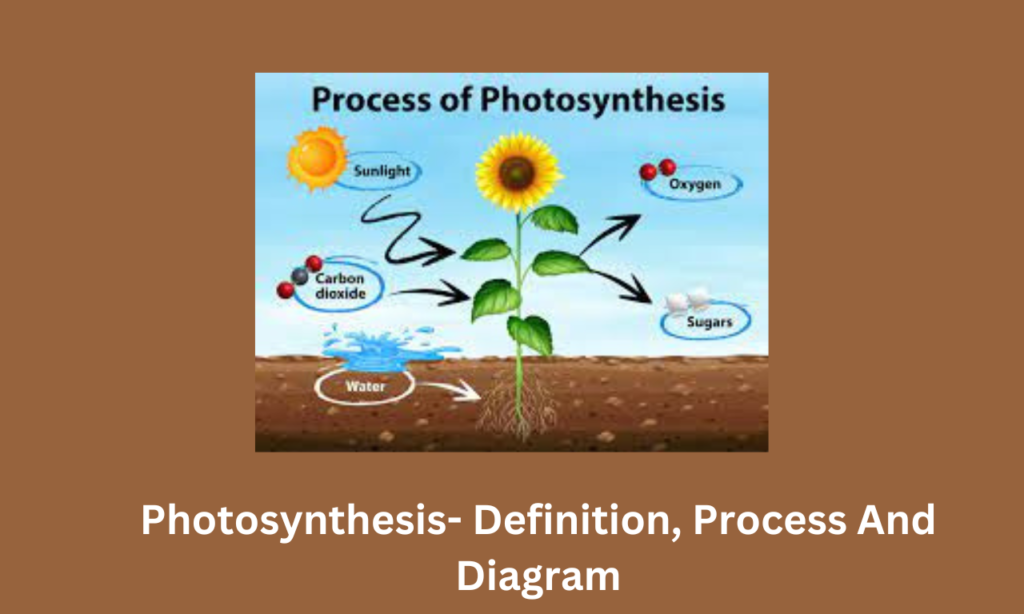Photosynthesis
Phototrophs employ a process called photosynthesis to transform light energy into chemical energy, which powers cellular processes. Made from carbon dioxide and water, sugars are the form in which the chemical energy is stored.
Definition
According to the definition of photosynthesis, pigments that are used in photosynthetic reactions, such as carotene, xanthophyll, and chlorophyll a, only occur in the chloroplasts. Photosynthesis is the process by which all green plants and a few other autotrophic organisms use carbon dioxide, water, and sunshine to manufacture nutrition. Oxygen is a byproduct of the process of photosynthesis. Let’s examine photosynthesis’s mechanism, outcome, and significance in more depth.
What Is Photosynthesis in Biology?
The Greek terms phōs (pronounced “fos”) and σύvεσις (pronounced “synthesis”) are the source of the word “photosynthesis.”Phōs signifies “light,” whereas σύνθεσις signifies “combining together.” “Combining together with the help of light” is what this signifies.
In addition to green plants, other creatures can also engage in photosynthesis. These comprise a variety of prokaryotes, including green sulfur bacteria, purple bacteria, and cyanobacteria. These creatures, like green plants, are phototrophic. Afterwards, the glucose generated by photosynthesis powers a number of cellular processes. Oxygen is a byproduct of this physio-chemical process.
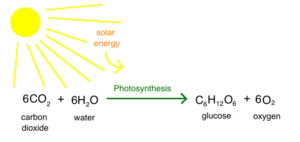
- Photosynthesis is also used by algae to convert solar energy into chemical energy. Oxygen is liberated as a by-product and light is considered as a major factor to complete the process of photosynthesis.
- Photosynthesis occurs when plants use light energy to convert carbon dioxide and water into glucose and oxygen. Leaves contain microscopic cellular organelles known as chloroplasts.
- Each chloroplast contains a green-coloured pigment called chlorophyll. Light energy is absorbed by chlorophyll molecules whereas carbon dioxide and oxygen enter through the tiny pores of stomata located in the epidermis of leaves.
- Another by-product of photosynthesis is sugars such as glucose and fructose.
- These sugars are then sent to the roots, stems, leaves, fruits, flowers and seeds. In other words, these sugars are used by the plants as an energy source, which helps them to grow. These sugar molecules then combine with each other to form more complex carbohydrates like cellulose and starch. The cellulose is considered as the structural material that is used in plant cell walls.
Where Does This Process Occur?
In plants and blue-green algae, photosynthesis takes place in chloroplasts. Chloroplasts, or green-colored plastids, are the building blocks of all green plant parts, such as green stems, green leaves, and sepals. These cell organelles are found in the mesophyll cells of leaves and are exclusive to plant cells.
Photosynthesis Equation
Water and carbon dioxide are the two reactants in the photosynthesis reaction. Oxygen and glucose are the two products that these two reactants produce. As a result, it is thought that the photosynthesis reaction is endothermic. The formula for photosynthesis is as follows:
6CO2 + 6H2O —> C6H12O6 + 6O2
Certain bacteria that carry out photosynthesis do not generate oxygen as a byproduct, in contrast to plants. Anoxygenic photosynthetic bacteria are the name given to such bacteria. Oxygenic photosynthetic bacteria are those that actually create oxygen as a byproduct of photosynthesis.
Photosynthetic Pigments
There are four different types of pigments present in leaves:
- Chlorophyll a
- Chlorophyll b
- Xanthophylls
- Carotenoids
Structure Of Chlorophyll

The green pigment known as chlorophyll can be found in cyanobacteria’s mesosomes and the chloroplasts of plant cells. Because it enables plants to absorb solar energy, this green pigment is essential to the process of photosynthesis. A combination of chlorophyll-a and chlorophyll-b is called chlorophyll. In addition to green plants, other photosynthesising species also possess different types of chlorophyll, including chlorophyll-c1, chlorophyll-c2, chlorophyll-d, and chlorophyll-f.
Process Of Photosynthesis
Chloroplasts are cellular organelles that are involved in the process of photosynthesis. The distinctive green color of the leaves is caused by a pigment called chlorophyll, which is found in these organelles.
As mentioned previously, photosynthesis takes place in leaves, and the specialized cell organelles called chloroplasts are in charge of this process. A leaf’s structural components are its lamina, epidermis, and petiole. During photosynthesis, the lamina is utilized to absorb carbon dioxide and sunlight.
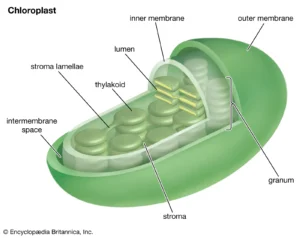
“Photosynthesis Steps:”
- During the process of photosynthesis, carbon dioxide enters through the stomata, water is absorbed by the root hairs from the soil and is carried to the leaves through the xylem vessels. Chlorophyll absorbs the light energy from the sun to split water molecules into hydrogen and oxygen.
- The hydrogen from water molecules and carbon dioxide absorbed from the air are used in the production of glucose. Furthermore, oxygen is liberated out into the atmosphere through the leaves as a waste product.
- Glucose is a source of food for plants that provide energy for growth and development, while the rest is stored in the roots, leaves and fruits, for their later use.
- Pigments are other fundamental cellular components of photosynthesis. They are the molecules that impart colour and they absorb light at some specific wavelength and reflect back the unabsorbed light. All green plants mainly contain chlorophyll a, chlorophyll b and carotenoids which are present in the thylakoids of chloroplasts. It is primarily used to capture light energy. Chlorophyll-a is the main pigment.
The process of photosynthesis occurs in two stages:
- Light-dependent reaction or light reaction
- Light independent reaction or dark reaction
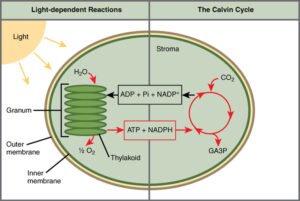
Light Reaction of Photosynthesis (or) Light-dependent Reaction
- Photosynthesis begins with the light reaction which is carried out only during the day in the presence of sunlight. In plants, the light-dependent reaction takes place in the thylakoid membranes of chloroplasts.
- The Grana, membrane-bound sacs like structures present inside the thylakoid functions by gathering light and is called photosystems.
- These photosystems have large complexes of pigment and proteins molecules present within the plant cells, which play the primary role during the process of light reactions of photosynthesis.
- There are two types of photosystems: photosystem I and photosystem II.
- Under the light-dependent reactions, the light energy is converted to ATP and NADPH, which are used in the second phase of photosynthesis.
- During the light reactions, ATP and NADPH are generated by two electron-transport chains, water is used and oxygen is produced.
The chemical equation in the light reaction of photosynthesis can be reduced to:
2H2O + 2NADP+ + 3ADP + 3Pi → O2 + 2NADPH + 3ATP
Dark Reaction of Photosynthesis (or) Light-independent Reaction
- Dark reaction is also called carbon-fixing reaction.
- It is a light-independent process in which sugar molecules are formed from the water and carbon dioxide molecules.
- The dark reaction occurs in the stroma of the chloroplast where they utilize the NADPH and ATP products of the light reaction.
- Plants capture the carbon dioxide from the atmosphere through stomata and proceed to the Calvin photosynthesis cycle.
- In the Calvin cycle, the ATP and NADPH formed during light reaction drive the reaction and convert 6 molecules of carbon dioxide into one sugar molecule or glucose.
The chemical equation for the dark reaction can be reduced to:
3CO2 + 6 NADPH + 5H2O + 9ATP → G3P + 2H+ + 6 NADP+ + 9 ADP + 8 Pi
* G3P – glyceraldehyde-3-phosphate
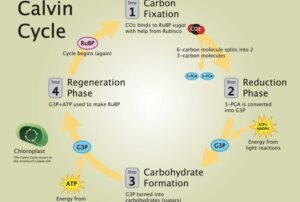
Photosynthesis- Definition, Process And Diagram- FAQs
Q1. What is Photosynthesis? Explain the process of photosynthesis.
Q2. What is the significance of Photosynthesis?
Ans. During photosynthesis, oxygen gas is liberated out into the environment and is utilized by humans, animals and other living species during the process of respiration.
Q3. List out the factors influencing Photosynthesis.

